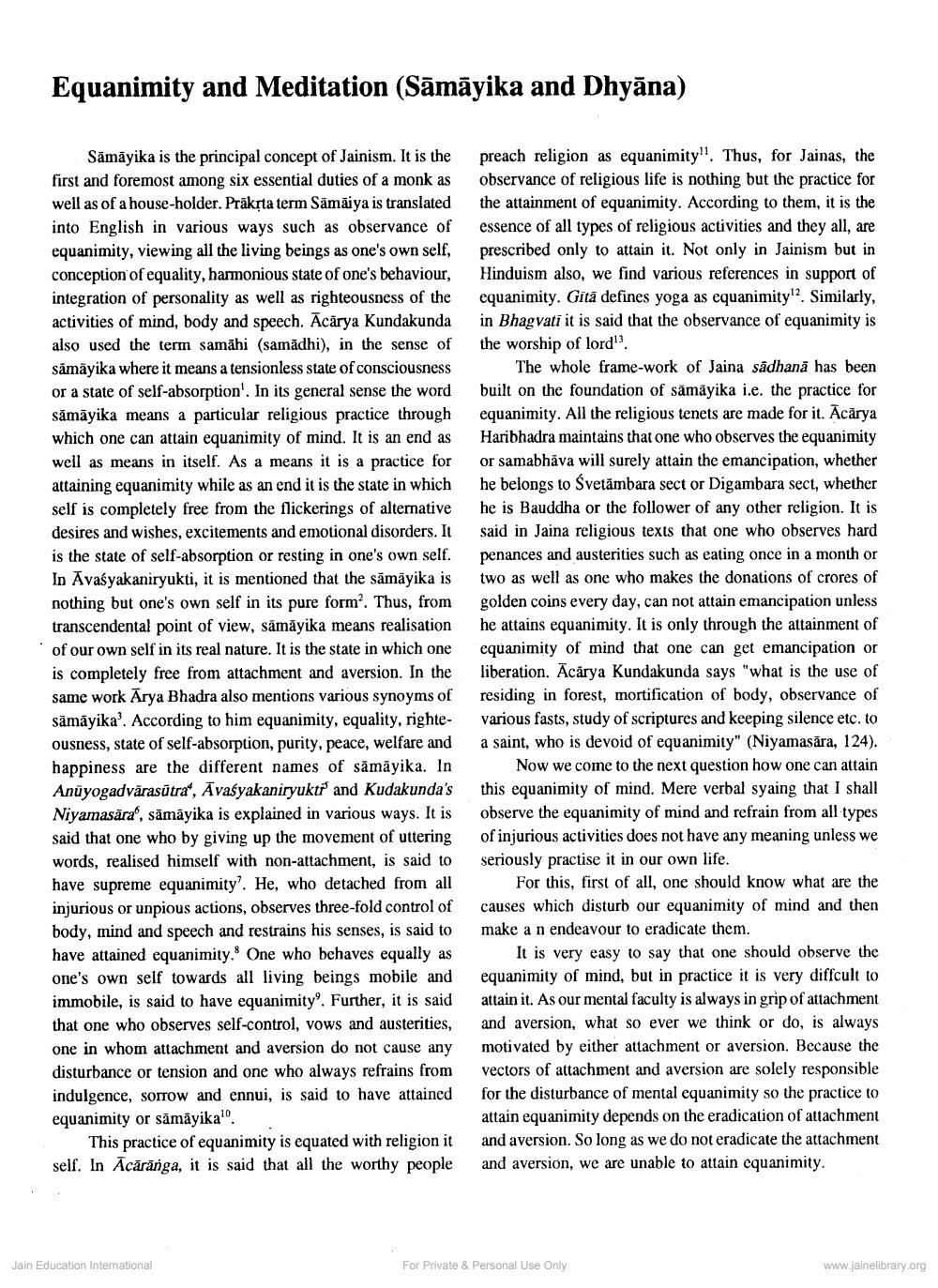Book Title: Equanimity and Meditation Author(s): Sagarmal Jain Publisher: Z_Shwetambar_Sthanakvasi_Jain_Sabha_Hirak_Jayanti_Granth_012052.pdf View full book textPage 1
________________ Equanimity and Meditation (Sāmāyika and Dhyāna) Sāmāyika is the principal concept of Jainism. It is the first and foremost among six essential duties of a monk as well as of a house-holder. Präksta term Sämäiya is translated into English in various ways such as observance of equanimity, viewing all the living beings as one's own self, conception of equality, harmonious state of one's behaviour, integration of personality as well as righteousness of the activities of mind, body and speech. Ācārya Kundakunda also used the term samāhi (samadhi), in the sense of sāmāyika where it means a tensionless state of consciousness or a state of self-absorption'. In its general sense the word sāmāyika means a particular religious practice through which one can attain equanimity of mind. It is an end as well as means in itself. As a means it is a practice for attaining equanimity while as an end it is the state in which self is completely free from the flickerings of alternative desires and wishes, excitements and emotional disorders. It is the state of self-absorption or resting in one's own self. In Avaśyakaniryukti, it is mentioned that the sāmāyika is nothing but one's own self in its pure form”. Thus, from transcendental point of view, sämāyika means realisation of our own self in its real nature. It is the state in which one is completely free from attachment and aversion. In the same work Arya Bhadra also mentions various synoyms of sāmāyika'. According to him equanimity, equality, righte- ousness, state of self-absorption, purity, peace, welfare and happiness are the different names of sāmāyika. In Anūyogadvārasūtra, Avaśyakaniryukti and Kudakunda's Niyamasăra', sāmāyika is explained in various ways. It is said that one who by giving up the movement of uttering words, realised himself with non-attachment, is said to have supreme equanimity? He, who detached from all injurious or unpious actions, observes three-fold control of body, mind and speech and restrains his senses, is said to have attained equanimity. One who behaves equally as one's own self towards all living beings mobile and immobile, is said to have equanimity. Further, it is said that one who observes self-control, vows and austerities, one in whom attachment and aversion do not cause any disturbance or tension and one who always refrains from indulgence, sorrow and ennui, is said to have attained equanimity or sāmāyika! This practice of equanimity is equated with religion it self. In Ācārārga, it is said that all the worthy people preach religion as equanimity'. Thus, for Jainas, the observance of religious life is nothing but the practice for the attainment of equanimity. According to them, it is the essence of all types of religious activities and they all, are prescribed only to attain it. Not only in Jainism but in Hinduism also, we find various references in support of equanimity. Gitá defines yoga as equanimity. Similarly, in Bhagvati it is said that the observance of equanimity is the worship of lord!). The whole frame-work of Jaina sadhanā has been built on the foundation of sämāyika i.e. the practice for equanimity. All the religious tenets are made for it. Acārya Haribhadra maintains that one who observes the equanimity or samabhāva will surely attain the emancipation, whether he belongs to Svetāmbara sect or Digambara sect, whether he is Bauddha or the follower of any other religion. It is said in Jaina religious texts that one who observes hard penances and austerities such as eating once in a month or two as well as one who makes the donations of crores of golden coins every day, can not attain emancipation unless he attains equanimity. It is only through the attainment of equanimity of mind that one can get emancipation or liberation. Acārya Kundakunda says "what is the use of residing in forest, mortification of body, observance of various fasts, study of scriptures and keeping silence etc. to a saint, who is devoid of equanimity" (Niyamasāra, 124). Now we come to the next question how one can attain this equanimity of mind. Mere verbal syaing that I shall observe the equanimity of mind and refrain from all types of injurious activities does not have any meaning unless we seriously practise it in our own life. For this, first of all, one should know what are the causes which disturb our equanimity of mind and then make a n endeavour to eradicate them. It is very easy to say that one should observe the equanimity of mind, but in practice it is very diffcult to attain it. As our mental faculty is always in grip of attachment and aversion, what so ever we think or do, is always motivated by either attachment or aversion. Because the vectors of attachment and aversion are solely responsible for the disturbance of mental equanimity so the practice to attain equanimity depends on the eradication of attachment and aversion. So long as we do not eradicate the attachment and aversion, we are unable to attain equanimity. Jain Education International For Private & Personal Use Only www.jainelibrary.orgPage Navigation
1 2 3 4 5
